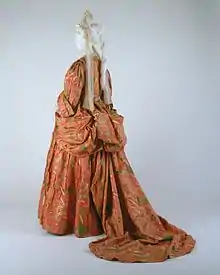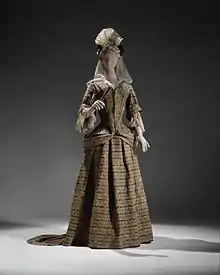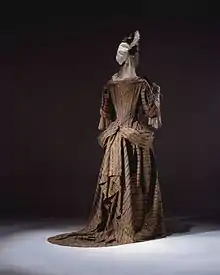Mantua (clothing)
A mantua (from the French manteuil or "mantle") is an article of women's clothing worn in the late 17th century and 18th century. Originally a loose gown, the later mantua was an overgown or robe typically worn over stays, stomacher and a co-ordinating petticoat.

The mantua or manteau was a new fashion that arose in the 1680s. Instead of a bodice and skirt cut separately, the mantua hung from the shoulders to the floor (in the manner of dresses of earlier periods) started off as the female version of the men's banyan, worn for 'undress' wear. Gradually it developed into a draped and pleated dress and eventually evolved into a dress worn looped and draped up over a contrasting petticoat and a stomacher. The mantua-and-stomacher resulted in a high, square neckline in contrast to the broad, off-the-shoulder neckline previously in fashion. The new look was both more modest and covered-up than previous fashions and decidedly fussy, with bows, frills, ribbons, and other trim, but the short string of pearls and pearl earrings or eardrops worn since the 1630s remained popular.
The mantua, made from a single length of fabric pleated to fit with a long train, was ideal for showing the designs of the new elaborately patterned silks that replaced the solid-colored satins popular in mid-century.[1]
Semantics
The origins of the term mantua to mean a robe are unclear. The garment may have been named after Mantua, in Italy, a centre of production for some of the expensive silks that would have been used to make up such garments. The term may also derive from manteau, the French term for a coat.
From this garment arose the term mantua-maker, an early term for a women's dressmaker.
Evolution of the mantua


The earliest mantuas emerged in the late 17th century as a comfortable alternative to the boned bodices and separate skirts then widely worn.
The mantua featured elbow-length, cuffed sleeves, and the overskirt was typically drawn back over the hips to expose the petticoat beneath. In the earliest mantuas, the long trained skirt was allowed to trail. From about 1710, it became customary to pin up the train. The construction of the mantua was altered so that once the train was pinned up, the exposed reverse of the train showed the proper face of the fabric or embroidery. One of the earliest extant examples of this, dated to 1710–1720, is in the Victoria and Albert Museum's collections.[2]
By the mid-18th century, the mantua had evolved into a formal version principally worn for court dress. The draping of the overskirt became increasingly stylized, with the back panel of the train almost entirely concealed.[3][4]
The final version of the mantua, circa 1780, bore little resemblance to the original mantuas of nearly a century earlier. Instead of earlier elaborate draperies and folds, the train had evolved into a length of fabric attached to the back of the bodice, as illustrated in an example in the Victoria and Albert Museum.[5]
Surviving examples

Extant examples of the 17th century mantua are extremely scarce. Perhaps the only known extant adult-size example is an embroidered wool mantua and petticoat[6] in the Metropolitan Museum of Art's Costume Institute. A pattern taken from this mantua has been published by Norah Waugh.[7] The Victoria and Albert Museum owns an extremely rare late 17th century fashion doll dressed in a pink silk mantua and petticoat.[8]
Also in the Costume Institute is a mantua and petticoat in salmon pink bizarre silk dated to 1708.[9] Another early mantua, the silk dated to c. 1708–09 belongs to the Clive House Museum, Shrewsbury; a pattern for this mantua has been taken by Janet Arnold.[10]
Most mantuas preserved in museum collections are formal versions from the mid-18th century, intended for court dress.
See also
References
- Ribeiro, Aileen, on the origins of the mantua in the late 17th century, in Dress in Eighteenth Century Europe 1715–1789; Ashelford, Jane, The Art of Dress
- Mantua dating to ca. 1720 in the Victoria and Albert Museum collections.
- 1744 mantua worn by Isabella Courtenay in the Victoria and Albert Museum collections.
- "Court dress [British] (C.I.65.13.1a-c)". In Heilbrunn Timeline of Art History. New York: The Metropolitan Museum of Art, 2000–. http://www.metmuseum.org/toah/hd/eudr/ho_C.I.65.13.1a-c.htm (October 2006)
- Mantua dated to 1775–85 in the Victoria & Albert Museum collections.
- Mantua [British] (33.54a,b)". In Heilbrunn Timeline of Art History. New York: The Metropolitan Museum of Art, 2000–. http://www.metmuseum.org/toah/hd/eudr/ho_33.54a,b.htm (October 2006)
- Waugh, Norah. The cut of women's clothes 1600–1930. London: Faber, 1968. ISBN 0-571-08594-6
- Lady Clapham's Mantua in the Victoria and Albert Museum collection.
- "Mantua [English] (1991.6.1a,b)". In Heilbrunn Timeline of Art History. New York: The Metropolitan Museum of Art, 2000–. http://www.metmuseum.org/toah/ho/09/euwb/ho_1991.6.1a,b.htm (October 2006)
- Arnold, Janet Patterns of Fashion 1: Englishwomen's dresses and their construction, c. 1660–1860. New ed. London: Macmillan 1977. ISBN 0-333-13606-3
Further reading
- Janet Arnold: Patterns of Fashion 1 (cut and construction of women's clothing, 1660–1860) Wace 1964, Macmillan 1972. (ISBN 0-89676-026-X)
External links
| Wikimedia Commons has media related to Mantua (clothing). |
